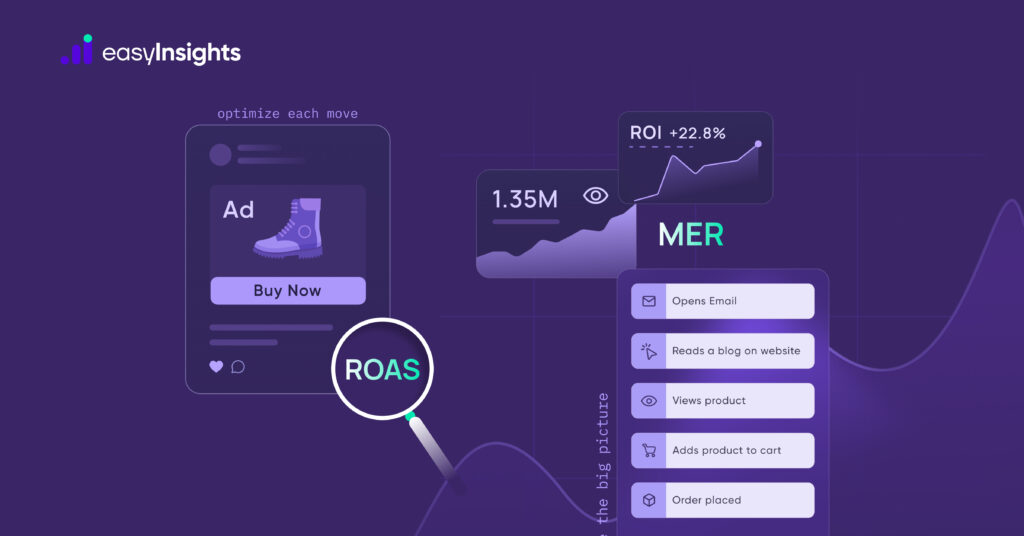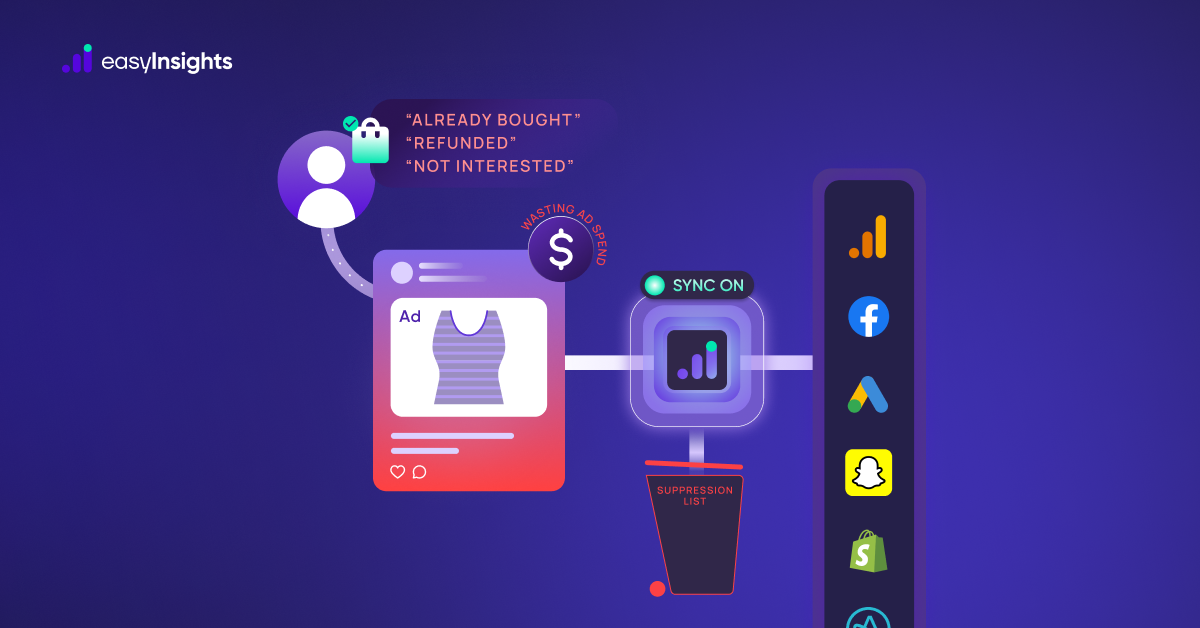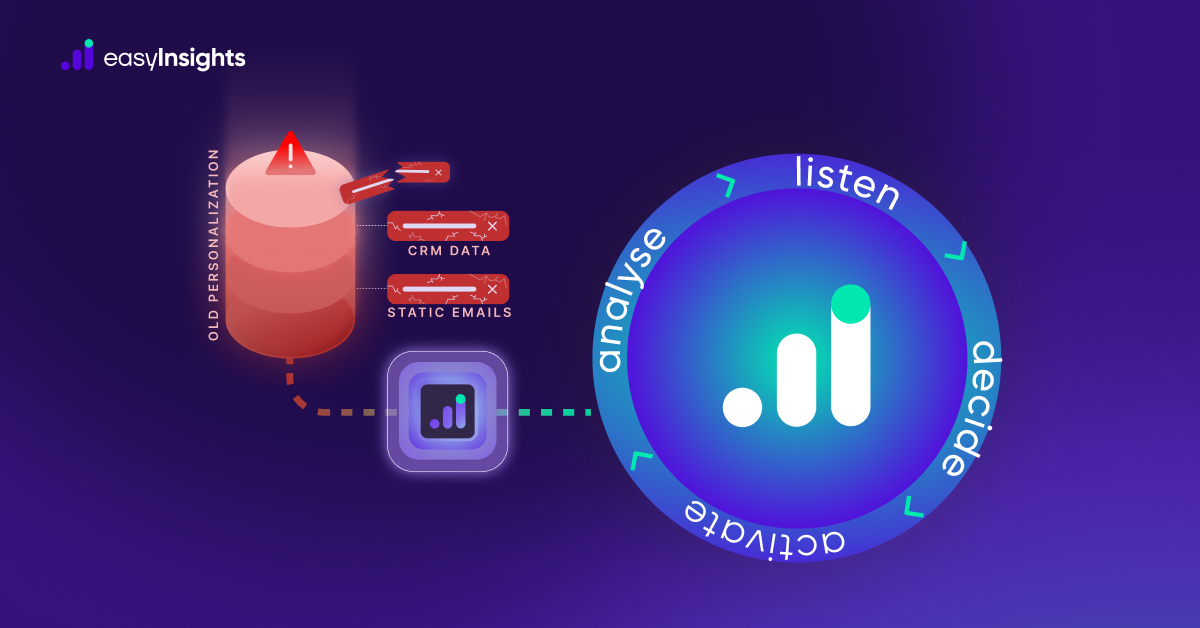
At first glance, they might look similar – but they tell very different stories. Understanding the distinction is crucial: the right metric can guide profitable growth, while relying on the wrong one can lead to wasted ad spend.
Modern marketers juggle tight budgets, ambitious growth goals, and increasingly complex customer journeys. Picking the appropriate metric at the right time can transform decision-making, highlight opportunities, and prevent costly blind spots.
In this guide, we’ll explain what MER and ROAS actually measure, how they differ, and how to use each effectively. You’ll also discover how to combine MER’s broad overview with ROAS’s campaign-level insights to optimize performance, balance short-term wins, and fuel long-term growth.
Jump ahead to:
What is Marketing Efficiency Ratio
Marketing Efficiency Ratio is a metric that measures the overall effectiveness of your marketing spend by comparing total revenue generated to total marketing costs.
For example, if your business earns $100,000 in revenue and spends $25,000 on marketing, your MER would be 4. This means that for every $1 spent on marketing, you generated $4 in revenue.
Unlike ROAS, which looks at the performance of individual campaigns or channels, MER provides a big-picture view of your marketing efficiency across all efforts. It’s a strategic metric that helps marketers understand overall profitability and make high-level budget decisions.
The Marketing Efficiency Ratio is calculated using a straightforward formula:
MER = Total Revenue ÷ Total Marketing/Ad Spend
What sets MER apart from typical campaign-level metrics is its holistic perspective. Instead of evaluating a single ad or channel, MER measures the effectiveness of all marketing activities combined, giving you a clear picture of how efficiently your overall marketing investment is driving revenue.

Because of this comprehensive approach, MER is often called blended ROAS or eROAS. It accounts not just for direct conversions, but also for indirect benefits like brand awareness, organic traffic growth, and cross-channel influence.
In some sectors, MER is also presented as TACoS (Total Advertising Cost of Sale). While the terminology differs, the goal remains the same: understanding how much revenue every dollar of total marketing spend generates.
MER goes beyond individual campaigns to measure overall marketing efficiency. By focusing on the big picture, it helps marketers cut through the noise of platform-specific metrics.
What is ROAS?
ROAS is an abbreviation for return on ad spend, which is a marketing metric that calculates how much revenue your company earns for every dollar spent on advertising. ROAS is, for all intents and purposes, the same as another metric you’re probably familiar with: return on investment or ROI. In this case, the money you spend on digital advertising is the investment on which you’re keeping track of the returns.
At its most basic, ROAS measures the effectiveness of your advertising efforts; the more effectively your advertising messages connect with your prospects, the more revenue you’ll earn per dollar spent on advertising. The higher your ROI, the better. If you want, you can measure ROAS at various levels within your Google Ads account, including the account, campaign, ad group, and so on. You can calculate ROAS as long as you know how much you’re spending and earning at that level.
Also Read: Everything You Need To Know About Marketing Attribution Models
MER vs ROAS: Understanding the Difference
While both metrics measure marketing efficiency, they operate at different levels and serve different goals.
| Aspect | MER (Marketing Efficiency Ratio) | ROAS (Return on Ad Spend) |
| Scope | Measures overall marketing performance across all channels | Focuses on specific campaigns or platforms |
| Perspective | Strategic, long-term view | Tactical, short-term view |
| Includes | All revenue (paid + organic, direct + indirect) | Only attributed revenue from ads |
| Use Case | Budget planning and overall efficiency tracking | Campaign optimization and ad performance |
| Ideal For | Founders, CMOs, growth teams | Performance marketers, media buyers |
In short, MER gives you the “forest” view, while ROAS shows you the “trees.” Both are valuable, but using one without the other can lead to incomplete insights.
When to Use MER or ROAS
Use MER when:
- You want to measure the overall health of your marketing investment.
- You’re planning budgets, evaluating total ROI, or assessing profitability.
- You’re in growth or scaling mode and need to see how marketing impacts the entire business.
Use ROAS when:
- You’re optimizing active campaigns or testing creatives.
- You need to evaluate ad efficiency at a granular level.
- You want to compare channels or audiences for tactical improvements.
The best marketers use both together – ROAS to optimize in the short term, and MER to ensure those optimizations drive long-term profitability.
Why MER Matters Today
Today’s customers don’t follow a straight path before buying. They might see your ad on Instagram, read a blog about your product, and finally buy it after searching on Google. In this omnichannel world, people interact with brands across many touchpoints before converting – which makes it harder for marketers to track which channel truly drove the sale, especially with stricter privacy rules and limited tracking data.
That’s where MER (Marketing Efficiency Ratio) comes in. Unlike platform-reported ROAS, which only shows what’s directly tracked, MER looks at the bigger picture. It measures your total revenue compared to your total marketing spend – no matter where or how the sale happens.
For example, a D2C brand might see a ROAS of 2.0 in Meta Ads Manager, suggesting average performance. But when they calculate MER across all marketing channels, it’s actually 3.5. This shows their Meta ads are also boosting sales from other sources, like organic search and email – something ROAS alone can’t always show.
How to Combine MER and ROAS for Smarter Decisions
- Start with ROAS for Tactical Insights
Use ROAS to test and optimize creatives, copy, and targeting. It’s your early indicator of performance. - Validate with MER for Strategic Impact
Once campaigns scale, track how your overall revenue and MER trend together. If ROAS looks great but MER drops, it means incremental revenue isn’t keeping up with spend. - Balance Short-Term Wins with Long-Term Growth
ROAS helps you drive efficiency in the short term. MER ensures that efficiency translates into sustainable, profitable growth.
Common Mistakes Marketers Make
Many brands use MER and ROAS the wrong way, which can lead to confusing data and wasted budget. Here are some common mistakes to watch out for.
- Relying only on ROAS: High ROAS doesn’t always mean profitability if overhead or total spend is too high.
- Ignoring indirect revenue: Channels like organic or influencer marketing contribute to revenue even if not directly attributed.
- Not tracking both metrics together: Without MER, you miss the full financial impact of your marketing.
How EasyInsights Helps You Track Both
Tracking MER and ROAS manually across multiple platforms can be time-consuming and error-prone. EasyInsights simplifies it all.
With automated data collection and accurate attribution, EasyInsights helps you:
- Track MER and ROAS in real time across every channel.
- Combine campaign-level and business-level metrics in a single location.
- Eliminate data silos and see which campaigns truly drive revenue growth.
Measure smarter, scale faster, and optimize every dollar of spend – effortlessly.
Conclusion
Both MER and ROAS are powerful metrics — but they serve different purposes. ROAS helps you understand how individual campaigns perform, while MER gives you a complete view of your overall marketing efficiency.
By using them together, marketers can balance short-term performance with long-term profitability. ROAS guides daily optimizations, and MER ensures those efforts truly drive business growth.
In a world where customers move across multiple channels before buying, relying on just one metric isn’t enough. MER connects the dots, helping you make smarter, data-backed decisions that scale sustainably.
Get complete visibility into your marketing performance – Book a demo with EasyInsights







